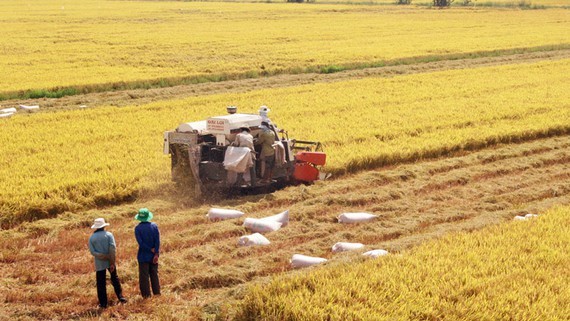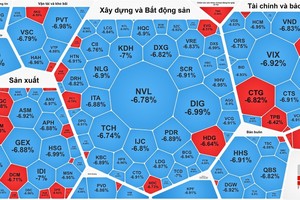
Vietnam’s rice exports have shown positive signs when the Government allowed to resume rice exports and the global demand for rice increased. The prices of Vietnamese rice also surged to the highest level in the past eight years, opening up many export opportunities.
Mr. Dien Van Ut, a farmer in Phuong Binh Commune in Phung Hiep District in Hau Giang Province said that right after he finished harvesting rice, traders bought the OM5451 rice variety at VND5,400 per kilogram at the field, as high as the price of rice in the previous winter-spring rice crop. Currently, farmers in Hau Giang Province have harvested nearly 5,000 hectares of summer-autumn rice with productivity at nearly 6.5 tons per hectare.
Summer-autumn rice was bought at VND5,400-VND5,800 per kilogram at the field and dried paddy was bought at VND6,100-VND7,100 per kilogram. At present, many traders are waiting to buy paddy from farmers right after harvesting, said Mr. Tran Chi Hung, Director of the Department of Agriculture and Rural Development of Hau Giang Province. In the summer-autumn rice crop, farmers grew rice on an area of 1.5 million hectares.
The export price of Vietnamese rice in May this year is considered to be the highest in the past eight years when hitting US$527 per ton up 21.4 percent compared to the same period last year. In June this year, the export price of 5-percent broken rice reached $473-$477 per ton, lower than that of Thailand by $30 per ton but higher than that of India by $100 per ton. According to the Ministry of Industry and Trade (MoIT), in the first six months of this year, rice exports of Vietnam might reach 3.7 million tons, much higher than the amount of rice for export of 3 million tons. Currently, many countries in the world pay great attention to food security amid the context of the ongoing Covid-19 pandemic. The MoIT said that Vietnam has a great opportunity to surpass Thailand in global rice exports this year with competitive export prices and increasing rice exports after the export quota is removed.
Accordingly, the Ministry of Agriculture and Rural Development (MARD) is considering increasing rice production to meet the increasing global demand for rice. According to the plan, the autumn-winter rice crop this year, the Mekong Delta provinces will maintain the rice-growing area at 750,000 hectares. However, the forecast said that the rice production of the world will possibly drop by 2.7 million tons and the demand for rice will increase by 3.7 million tons. The ministry will closely watch the developments of the market to adjust the rice-growing area of the autumn-winter rice crop to around 800,000 hectares if possible. It will focus on determining the crop calendar, the flood areas, the crop structure, and suitable technical solutions for the autumn-winter rice crop, said Minister Nguyen Xuan Cuong of the MARD.
However, increasing the area of autumn-winter rice crop also makes farmers and scientists worry because with this expansion, how the downstream areas of Ben Tre, Hau Giang, Soc Trang, Bac Lieu, and Ca Mau provinces will be affected during the dry season. Earlier, farmers in the Mekong Delta provinces merely grew 200,000-300,000 hectares of autumn-winter rice crop. The regions of Long Quyen Quadrangle and Dong Thap Muoi (Plain of Reeds) are usually not used to grow the autumn-winter rice crop and left to be flooded by rains and floods. These two regions become two water reservoirs with a total area of about 1.2 million hectares to regulate water for the Mekong Delta. They keep water during the rainy and flood season then gradually release water to Tien and Hau rivers to help to reduce saltwater intrusion in the dry season. Therefore, farmers in the downstream area of the Mekong Delta, and scientists said that the MARD should consider and evaluate the pros and cons when increasing the area of autumn-winter rice crop. The impacts of saltwater intrusion and drought were extremely serious, damaging fruit trees, vegetables, and rice, causing a widespread shortage of fresh water in the coastal area.
Many people think that the rice-growing area of the autumn-winter rice crop should only be at 300,000-500,000 hectares and farmers should concentrate on growing high-quality rice varieties. Because in recent years, the ratio of fragrant, specialty, and high-quality rice of Vietnam accounted for more than 80 percent of the total export amount. Many institutes, universities, and Vietnamese rice exporting enterprises currently are focusing on researching and creating high-quality rice varieties following the market demand. Rice exports of Vietnam are facing a great opportunity to enter the EU market when the EU-Vietnam Free Trade Agreement becomes effective. Although the export quota to this market is merely around 80,000 tons of rice, this is considered as a segment of high-quality rice. Some Vietnamese enterprises have prepared the raw material areas in the past few years to meet the strict requirements of this market, along with strict production processes. This is an important foundation for Vietnamese enterprises to diversify the segments of fragrant and high-quality rice to choosy markets.
























